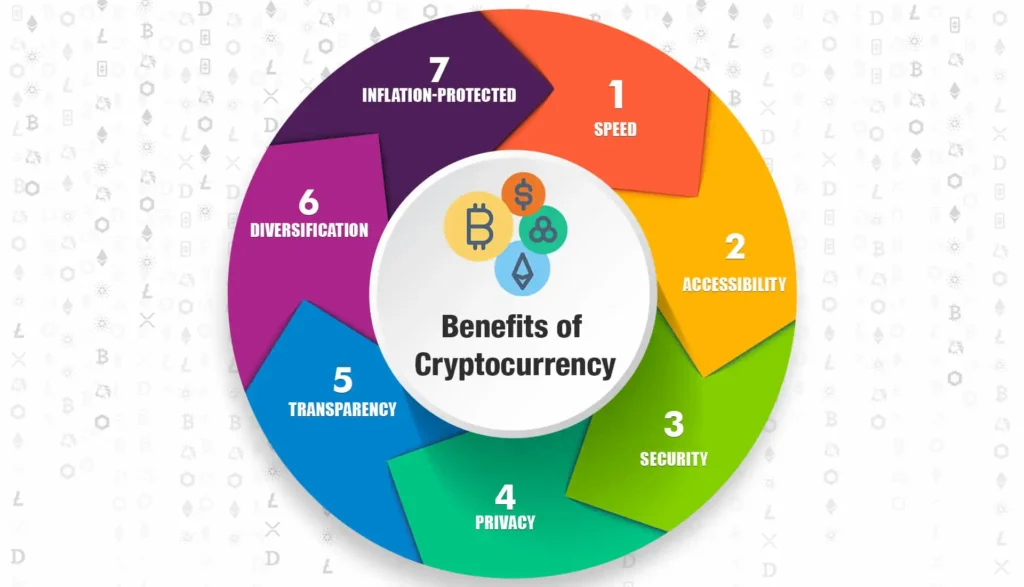
18,000! Yes, there are that many cryptocurrencies today! But depending on who you ask, that is either too many or too few. No matter which side of the fence you are on, the truth is, cryptocurrencies are, in fact, finite. So while many have already fallen prey to the allure of cryptocurrencies and the quick, super-secure, blockchain-enabled transactions they offer, many remain wary. Some others are timidly dipping their toes, wondering what lies ahead. If you are also considering investing in cryptocurrency or have been wondering what all the fuss is about, welcome! Let’s dive right in.
What is cryptocurrency?
Cryptocurrency is a virtual currency that works as a medium of exchange using computer networks. A peer-to-peer network called ‘blockchain’ monitors cryptocurrencies and serves as a secure ledger for transactions. What this effectively does is eliminate the middleman. Banks or credit card companies usually act as the central authorities that control and monitor transactions between individuals. But, as all intermediaries do, they too take a cut for their role in facilitating the secure exchange of money. Blockchain achieves decentralisation, democratisation, and transparency in one giant sweep, making it one of the most exciting innovations in recent years.
The first widely-recognised cryptocurrency was Bitcoin. However, it has been volatile in price. In July 2010, Bitcoin’s value was $0.0008. This cryptocurrency reached its record high price in November 2021 at $68,990.90, and its current value at the time of writing is $42,010.70. Your life would have been entirely different if you were Jeremy Sturdivant, the pizza guy who was paid 10,000 bitcoins for two pizzas on May 22, 2010. So, rightly enough, the day is called Bitcoin Pizza Day.
Bitcoin soon became the de facto standard for cryptocurrencies. So much so that people started using the two words interchangeably. So strong has Bitcoin’s influence been on the crypto market that any deviation in its price is sure to cause some kind of upheaval in the market. As Bitcoin became the norm, all other crypto coins were termed ‘altcoins’. Altcoins try to improve upon Bitcoin’s limitations by minimising energy consumption, reducing the time to validate transactions, and increasing stability and sustainability. Some popular altcoins are Ripple, Ethereum, Bitcoin Cash, Solana, and Bitcoin SV.
How does it work?
As we have already seen, cryptocurrencies run on the blockchain, which is essentially a database or decentralised public ledger that holds a record of all transactions between crypto owners. Essentially, the “blockchain” is a chronological history of past transactions, separated into groups called blocks. As these blocks are visible to everyone using that particular network, the probability of wrongdoing is relatively low. Further, all the block-related decision-making happens unanimously, making it a democratic and equitable process.
Individual cryptocurrency units are created using a process called ‘mining’. Much like physical mining, mining for crypto also involves some heavy lifting. But, of course, being a digital entity, the labour involved is more cerebral than physical. First, a super complicated mathematical problem needs to be solved. Then, when it is solved, using several kilowatts of power, a new coin is generated.
For the uninitiated and still confused, here is an interesting analogy to understand the process of mining. Imagine there is a colouring book that everyone wants to use. There is an ongoing contest to see who will get to own and colour the next page. This contest is comparable to the puzzle-solving or mining for new bitcoin: the winner decides who gets to own the new block to the blockchain. Finally, after all the participants complete complex tasks to prove their worth, someone wins. The prize, of course, is the promised access to the next page of the book. Once the winner colours the page, the contest resumes, and the competition for the next page begins. This competition continues till the competitors finish the book (the finite cryptocurrencies get used up).
Reasons why we love cryptocurrencies

Traditional currencies, also called fiat currencies, are managed in a centralised, hub-and-spoke system. However, cryptocurrencies are disruptive, subversive, and revolutionary in a manner that has the potential to redefine financial markets and economies. A direct challenge to the traditional banking norms, blockchain technology, in conjunction with cryptocurrency, has ushered in a range of novel, exciting, and efficient ways of conducting transactions. Let’s glance at their benefits.
Speed:
Far superior to financial institutions, which take up to 3 to 5 days, cryptocurrency transactions take a few minutes.
Accessibility:
Cryptocurrency is accessible to anyone with a smartphone or computer and an Internet connection, off-setting the requirements of credit check and ID verification. Bit of a libertarian’s dream, cryptocurrencies are gradually working towards reducing government interference.
Security:
Surpassing fiat currencies by a wide margin, cryptocurrencies require private keys to access crypto wallets, in the absence of which even the owner cannot recover it. Thus, apart from being completely failsafe, it also gives you ample reason to be careful about not forgetting your passcode!
Privacy:
Some may say that the anonymity that cryptocurrency transactions offer might be a double-edged sword. However, in a world where surveillance is increasingly becoming the norm, not having identifiable information to trace may start uncomfortable conversations around individuals’ right to privacy.
Transparency:
Because blockchain is a distributed ledger, all the participants have access to the transactions. This increased transparency may automatically bring down foul play and breaching of contracts, something the very cloak-and-dagger traditional financial systems could learn from.
Diversification:
Why only stick to stocks and bonds when you can buy a host of other things, including NFTs? Thanks to cryptocurrency, the daily trading game has taken on a whole new form.
Inflation-protected:
Rising prices are the bane of everybody’s existence. Cryptocurrencies, however, can provide significant relief as they are inflation-resistant. Moreover, thanks to their finiteness, manipulation in the form of money printing, demonetisation, and tweaking of interest rates is no more a concern, and we are absolutely chuffed about that!
What can you buy with cryptocurrency?
If you thought that cryptocurrencies were digital and held no value in the real world, you are mistaken. Remember the Winklevoss twins from The Social Network movie? In 2014, the real-life Winklevoss twins converted thousands of bitcoins into cash to fund a $500,000 outer space trip via Virgin Galactic. Imagine the millions and millions they could have had if they hadn’t squandered it on a space trip! Thankfully, they didn’t exhaust their entire bitcoin portfolio. In an interview, Tyler Winklevoss said, “Spend cash, invest in Bitcoin. Cash is trash.”
From Tesla’s electric cars to insurance, there are many ways to use cryptocurrencies in place of fiat currency. To make purchases using crypto, you need to get a cryptocurrency debit card that is available on major crypto exchanges. You can even purchase on Amazon with Bitcoin, using a 3rd party service called Purse. Mastercard announced last year that it was introducing a crypto-based debit card in association with Bitpay. You could use it with more than 3,000 merchants worldwide. PayPal also recently declared that its US customers could buy, sell, or hold cryptocurrencies over its platforms.
Future of cryptocurrency? Not so cryptic, after all!
Cryptocurrency is like Muhammad Ali of yore; you can like it or hate it, but you cannot ignore it. Even though the rapid pace at which cryptocurrency is becoming a part of our mainstream lives isn’t unexpected, what exactly does the future hold?
Analysts estimate that the global cryptocurrency market will triple by 2030. Rest assured, in years to come, cryptocurrencies will become more widely accepted. We predict even the old guard governments will soon get on board. Likewise, the growth of 3D virtual worlds in the metaverse will accelerate the mainstream adoption of cryptocurrencies. From the moment Facebook announced that it was building its own virtual world and rebranded to Meta, the crypto hustle has pretty much taken a life of its own!
The adoption of cryptocurrency will further increase once people get accustomed to its functionality, security, and usability. Until then, we would like to remind the average investor that patience is a virtue. But one thing is sure: good things come to those who wait, and cryptocurrencies are indeed up and coming!




good article
The crypto hustle is real!